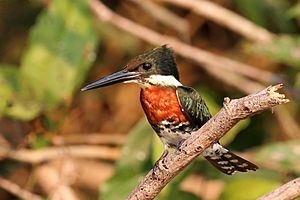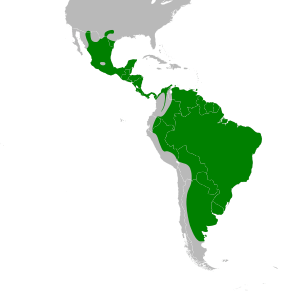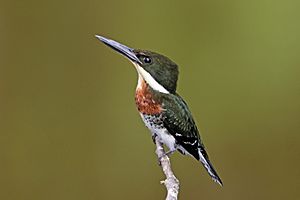Green kingfisher facts for kids
Quick facts for kids Green kingfisher |
|
|---|---|
 |
|
| Male C. a. americana, the Pantanal, Brazil | |
| Conservation status | |
| Scientific classification | |
| Genus: |
Chloroceryle
|
| Species: |
americana
|
| Subspecies | |
|
C. a. americana |
|
 |
|

The green kingfisher (Chloroceryle americana) is a small, colorful bird found from the southern Texas in the United States all the way down to central Argentina in South America. These birds live near streams in forests or mangroves (coastal trees).
You can often spot them sitting quietly on a low branch near the water. They suddenly dive headfirst to catch fish! They also enjoy eating water insects. Listen for their unique 'pebbly rattling' call.
Contents
About the Green Kingfisher
The green kingfisher is a small bird, about 20 centimeters (8 inches) long. Males usually weigh between 29 and 40 grams, while females are a bit heavier, weighing 33 to 55 grams.
Like other kingfishers, they have a short tail and a long, pointed bill. Their feathers are an oily green color on top, with white markings on their wings and tail. They also have a white collar around their neck.
How to Tell Males and Females Apart
It's easy to tell male and female green kingfishers apart!
- Males have white feathers on their belly. They also have a wide, reddish-brown band across their chest. You might see some green spots on their sides.
- Females have buff-white (a creamy white) feathers on their belly. Instead of one reddish band, they have two green bands across their chest. The lower green band connects to green spots along the sides of their belly.
Where Green Kingfishers Live
The green kingfisher lives in many different places across the Americas. Scientists have identified five different types, called subspecies, based on where they live:
- C. a. hachisukai: Found in the south-central USA and northwest Mexico.
- C. a. septentrionalis: Lives from south-central Texas and eastern Mexico down to northern Colombia and western Venezuela.
- C. a. americana: This type is found in South America, east of the Andes mountains. This includes Venezuela, northeast Bolivia, northern and central Brazil, and the islands of Trinidad and Tobago.
- C. a. mathewsii: Lives in southern Brazil, southern Bolivia, and northern Argentina.
- C. a. cabanisii: Found in Colombia all the way to Chile, west of the Andes mountains.
Life Cycle and Reproduction
Green kingfishers are very good at building their nests. They prefer to nest near streams in forests or mangrove areas.
Nest Building
Both the male and female kingfisher work together to dig a horizontal tunnel in a river bank. This tunnel is usually about 5 to 6 centimeters (2 inches) wide and can be up to 1 meter (3 feet) long!
Eggs and Chicks
The female kingfisher lays between three and six white eggs. The female sits on the eggs at night to keep them warm. During the day, both parents take turns incubating the eggs.
After the chicks hatch, they stay in the nest for about 27 days. During this time, both parents bring them food. Once they are old enough, the young birds leave the nest.
What They Eat
Green kingfishers are expert hunters! They mostly eat fish, which they catch by diving headfirst into the water. They are also known to eat aquatic insects that live in the water.
They often sit very still on a low, shaded branch near the water. They wait patiently until they spot a fish or insect, then quickly plunge in to catch it.
See also
 In Spanish: Martín pescador verde para niños
In Spanish: Martín pescador verde para niños
Images for kids



